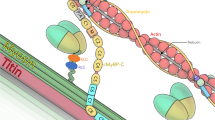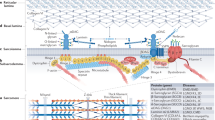Abstract
Tropomyosin (Tm) and the troponins (troponin I, troponin T and troponin C) are proteins that work cooperatively to regulate muscle contraction, making actin-myosin interactions sensitive to cytosolic calcium levels. Several isoforms exist for each component in this group, each having a specific expression pattern that enables cardiac, slow skeletal (type 1) and fast skeletal (type 2) muscle fibers to have distinct contractile properties. Mutations in all components of this complex have been associated with skeletal muscle disease. The first disease associations were with nemaline myopathy, but recently other congenital myopathies (‘cap disease,’ congenital fiber type disproportion) and other clinical entities (distal arthrogryposis, multiple pterygium syndrome) have been linked to mutations. A homozygous mutation in CFL2, the gene for muscle cofilin, has been associated with nemaline myopathy in one family to date. Researchers have begun to decipher the mechanisms by which these mutations result in muscle weakness and contractures using a variety of in vitro assays to assess the effects of individual mutations on protein function and on sarcomere dynamics.
Access this chapter
Tax calculation will be finalised at checkout
Purchases are for personal use only
Preview
Unable to display preview. Download preview PDF.
Similar content being viewed by others
References
Perry SV. Vertebrate tropomyosin: distribution, properties and function. J Muscle Res Cell Motil 2001; 22:5–49.
Schevzov G, Vrhovski B, Bryce NS et al. Tissue-specific tropomyosin isoform composition. J Histochem Cytochem 2005; 53:557–570.
Gordon AM, Regnier M, Homsher E. Skeletal and cardiac muscle contractile activation: tropomyosin “rocks and rolls”. News Physiol Sci 2001; 16:49–55.
Pieples K, Wieczorek DF. Tropomyosin 3 increases striated muscle isoform diversity. Biochemistry 2000; 39:8291–8297.
Salviati G, Betto R, Danieli BD et al. Myofibrillar-protein isoforms and sarcoplasmic-reticulum Ca2+-transport activity of single human muscle fibers. Biochem J 1984; 224:215–225.
Leger J, Bouveret P, Schwartz K et al. A comparative study of skeletal and cardiac tropomyosins: Subunits, thiol group content and biological activities. Pflugers Arch 1976; 362:271–277.
Bronson DD, Schachat FH. Heterogeneity of contractile proteins. Differences in tropomyosin in fast, mixed and slow skeletal muscles of the rabbit. J Biol Chem 1982; 257:3937–3944.
Brown HR, Schachat FH. Renaturation of skeletal muscle tropomyosin: Implications for in vivo assembly. Proc Natl Acad Sci USA 1985; 82:2359–2363.
Ochala J, Li M, Tajsharghi H et al. Effects of a R133W beta-tropomyosin mutation on regulation of muscle contraction in single human muscle fibers. J Physiol 2007; 581:1283–1292.
Gordon AM, Homsher E, Regnier M. Regulation of contraction in striated muscle. Physiol Rev 2000; 80:853–924.
Thierfelder L, Watkins H, MacRae C et al. Alpha-tropomyosin and cardiac troponin T mutations cause familial hypertrophic cardiomyopathy: A disease of the sarcomere. Cell 1994; 77:701–712.
Mogensen J, Murphy RT, Shaw T et al. Severe disease expression of cardiac troponin C and T mutations in patients with idiopathic dilated cardiomyopathy. J Am Coll Cardiol 2004; 44:2033–2040.
Kimura A, Harada H, Park JE et al. Mutations in the cardiac troponin I gene associated with hypertrophic cardiomyopathy. Nat Genet 1997; 16:379–382.
Donner K, Ollikainen M, Ridanpaa M et al. Mutations in the beta-tropomyosin (TPM2) gene—A rare cause of nemaline myopathy. Neuromuscul Disord 2002; 12:151–158.
Ryan MM, Ilkovski B, Strickland CD et al. Clinical course correlates poorly with muscle pathology in nemaline myopathy. Neurology 2003; 60:665–673.
Hall JG, Reed SD, Greene G. The distal arthrogryposes: Delineation of new entities—Review and nosologic discussion. Am J Med Genet 1982; 11:185–239.
Beals RK. The distal arthrogryposes: A new classification of peripheral contractures. Clin Orthop Relat Res 2005; 203–210.
Jouk P, Labarre-Vila A, Mezin P et al. A homozygous null mutation in TPM2 gene causes autosomal recessive nemaline myopathy associated with multiple pterygia (Abstract). World Muscle Society 12th International Congress, Sicily, Italy. Neuromusc Disord 2007; 17:837.
Tajsharghi H, Kimber E, Holmgren D et al. Distal arthrogryposis and muscle weakness associated with a beta-tropomyosin mutation. Neutrology 2007; 68:772–775.
Lehtokari VL, Ceuterick-de Groote C, de Jonghe P et al. Cap disease caused by heterozygous deletion of the beta-tropomyosin gene TPM2. Neuromuscul Disord 2007; 17:433–442.
Tajsharghi H, Ohlsson M, Lindberg C et al. Congenital myopathy with nemaline rods and cap structures caused by a mutation in the beta-tropomyosin gene (TPM2). Arch Neurol 2007; 64:1334–1338.
Fidzianska A, Badurska B, Ryniewicz B et al. “Cap disease”: New congenital myopathy. Neurology 1981; 31:1113–1120.
Bamshad M, Watkins WS, Zenger RK et al. A gene for distal arthrogryposis type I maps to the pericentromeric region of chromosome 9. Am J Hum Genet 1994; 55:1153–1158.
Sung SS, Brassington AM, Grannatt K et al. Mutations in genes encoding fast-twitch contractile proteins cause distal arthrogryposis syndromes. Am J Hum Genet 2003; 72:681–690.
Kohn WD, Kay CM, Hodges RS. Orientation, positional, additivity and oligomerization-state effects of interhelical ion pairs in alpha-helical coiled-coils. J Mol Biol 1998; 283:993–1012.
Brown JH, Zhou Z, Reshetnikova L et al. Structure of the mid-region of tropomyosin: Bending and binding sites for actin. Proc Natl Acad Sci USA 2005; 102:18878–18883.
Robinson P, Lipscomb S, Preston LC et al. Mutations in fast skeletal troponin I, troponin T and beta-tropomyosin that cause distal arthrogryposis all increase contractile function. FASEB J 2007; 21:896–905.
Corbett MA, Akkari PA, Domazetovska A et al. An alphaTropomyosin mutation alters dimer preference in nemaline myopathy. Ann Neurol, 2005; 57:42–49.
den Dunnen JT, Antonarakis SE. Nomenclature for the description of human sequence variations. Hum Genet 2001; 109:121–124.
Penisson-Besnier I, Monnier N, Toutain A et al. A second pedigree with autosomal dominant nemaline myopathy caused by TPM3 mutation: A clinical and pathological study. Neuromuscul Disord 2007; 17:330–337.
Araya E, Berthier C, Kim E et al. Regulation of coiled-coil assembly in tropomyosins. J Struct Biol 2002; 137:176–183.
Dufour C, Weinberger RP, Schevzov G et al. Splicing of two internal and four carboxyl-terminal alternative exons in nonmuscle tropomyosin 5 premRNA is independently regulated during development. J Biol Chem 1998; 273:18547–18555.
Laing NG, Wilton SD, Akkari PA et al. A mutation in the alpha tropomyosin gene TPM3 associated with autosomal dominant nemaline myopathy NEM1. Nat Genet 1995; 9:75–79.
Clarke NF, Kolski H, Dye DE et al. Mutations in TPM3 are a common cause of congenital fiber type disproportion. Ann Neurol. 2008 Mar:63(3):329–37.
Clarke NF, Ilkovski B, Cooper S et al. The pathogenesis of ACTA1-related congenital fiber type disproportion. Ann Neurol 2007; 61:552–561.
Laing NG, Majda BT, Akkari PA et al. Assignment of a gene (NEMI) for autosomal dominant nemaline myopathy to chromosome I. Am J Hum Genet 1992; 50:576–583.
Tan P, Briner J, Boltshauser E et al. Homozygosity for a nonsense mutation in the alpha-tropomyosin slow gene TPM3 in a patient with severe infantile nemaline myopathy. Neuromuscul Disord 1999; 9:573–579.
Durling HJ, Reilich P, Muller-Hocker J et al. De novo missense mutation in a constitutively expressed exon of the slow alpha-tropomyosin gene TPM3 associated with an atypical, sporadic case of nemaline myopathy. Neuromuscul Disord 2002; 12:947–951.
Wattanasirichaigoon D, Swoboda KJ, Takada F et al. Mutations of the slow muscle alpha-tropomyosin gene, TPM3, are a rare cause of nemaline myopathy. Neurology 2002; 59:613–617.
Lehtokari VL, Pelin K, Donner K et al. Identification of a founder mutation in TPM3 in nemaline myopathy patients of Turkish origin. Eur J Hum Genet. 2008 Apr 2; [Epub ahead of print] PMID: 18382475.
Wagschal K, Tripet B, Lavigne P et al. The role of position a in determining the stability and oligomerization state of alpha-helical coiled coils: 20 amino acid stability coefficients in the hydrophobic core of proteins. Protein Sci 1999; 8:2312–2329.
Corbett MA, Robinson CS, Dunglison GF et al. A mutation in alpha-tropomyosin(slow) affects muscle strength, maturation and hypertrophy in a mouse model for nemaline myopathy. Hum Mol Genet 2001; 10:317–328.
Akkari PA, Song Y, Hitchcock-DeGregori S et al. Expression and biological activity of Baculovirus generated wild-type human slow alpha tropomyosin and the Met9Arg mutant responsible for a dominant form of nemaline myopathy. Biochem Biophys Res Commun 2002; 296:300–304.
Moraczewska J, Greenfield NJ, Liu Y et al. Alteration of tropomyosin function and folding by a nemaline myopathy-causing mutation. Biophys J 2000; 79:3217–3225.
Greenfield NJ, Fowler VM. Tropomyosin requires an intact N-terminal coiled coil to interact with tropomodulin. Biophys J 2002; 82:2580–2591.
de Haan A, van der Vliet MR, Gommans IM et al. Skeletal muscle of mice with a mutation in slow alpha-tropomyosin is weaker at lower lengths. Neuromuscul Disord 2002; 12:952–957.
Michele DE, Albayya FP, Metzger JM. A nemaline myopathy mutation in alpha-tropomyosin causes defective regulation of striated muscle force production. J Clin Invest 1999; 104:1575–1581.
Johnston JJ, Kelley RI, Crawford TO et al. A novel nemaline myopathy in the Amish caused by a mutation in troponin T1. Am J Hum Genet 2000; 67:814–821.
Jin JP, Brotto MA, Hossain MM et al. Truncation by Glu180 nonsense mutation results in complete loss of slow skeletal muscle troponin T in a lethal nemaline myopathy. J Biol Chem 2003; 278:26159–26165.
Wang X, Huang QQ, Breckenridge MT et al. Cellular fate of truncated slow skeletal muscle troponin T produced by Glu180 nonsense mutation in amish nemaline myopathy. J Biol Chem 2005; 280:13241–13249.
Sung SS, Brassington AM, Krakowiak PA et al. Mutations in TNNT3 Cause Multiple Congenital Contractures: A Second Locus for Distal Arthrogryposis Type 2B. Am J Hum Genet 2003; 73:212–214.
Varnava A, Baboonian C, Davison F et al. A new mutation of the cardiac troponin T gene causing familial hypertrophic cardiomyopathy without left ventricular hypertrophy. Heart 1999; 82:621–624.
Krakowiak PA, O’Quinn JR, Bohnsack JF et al. A variant of Freeman-Sheldon syndrome maps to 11p15.5-pter. Am J Hum Genet 1997; 60:426–432.
Drera B, Zoppi N, Barlati S et al. Recurrence of the p.R156X TNN12 mutation in distal arthrogryposis type 2B. Clin Genet 2006; 70:532–534.
Jiang M, Zhao X, Han W et al. A novel deletion in TNN12 causes distal arthrogryposis in a large Chinese family with marked variability of expression. Hum Genet 2006; 120:238–242.
Kimber E, Tajsharghi H, Kroksmark AK et al. A mutation in the fast skeletal muscle troponin 1 gene causes myopathy and distal arthrogryposis. Neurology 2006; 67:597–601.
Shrimpton AE, Hoo JJ. A TNN12 mutation in a family with distal arthrogryposis type 2B. Eur J Med Genet 2006; 49:201–206.
Toydemir RM, Rutherford A, Whitby FG et al. Mutations in embryonic myosin heavy chain (MYH3) cause Freeman-Sheldon syndrome and Sheldon-Hall syndrome. Nat Genet 2006; 38:561–565.
Ramos CH. Mapping subdomains in the C-terminal region of troponin I involved in its binding to troponin C and to thin filament. J Biol Chem 1999; 274:18189–18195.
Thirion C, Stucka R, Mendel B et al. Characterization of human muscle type cofilin (CFL2) in normal and regenerating muscle. Eur J Biochem 2001; 268:3473–3482.
Agrawal PB, Greenleaf RS, Tomczak KK et al. Nemaline myopathy with minicores caused by mutation of the CFL2 gene encoding the skeletal muscle actin-binding protein, cofilin-2. Am J Hum Genet 2007; 80:162–167.
Oldfors A. Hereditary myosin myopathies. Neuromuscul Disord 2007; 17:355–367.
Geisterfer-Lowrance AA, Kass S, Tanigawa G et al. A molecular basis for familial hypertrophic cardiomyopathy: a beta cardiac myosin heavy chain gene missense mutation. Cell 1990; 62:999–1006.
Meredith C, Herrmann R, Parry C et al. Mutations in the slow skeletal muscle fiber myosin heavy chain gene (MYH7) cause laing early-onset distal myopathy (MPD1). Am J Hum Genet 2004; 75:703–708.
Vrhovski B, Lemckert F, Gunning P. Modification of the tropomyosin isoform composition of actin filaments in the brain by deletion of an alternatively spliced exon. Neuropharmacology 2004; 47:684–693.
Author information
Authors and Affiliations
Editor information
Editors and Affiliations
Rights and permissions
Copyright information
© 2008 Landes Bioscience and Springer Science+Business Media
About this chapter
Cite this chapter
Clarke, N.F. (2008). Skeletal Muscle Disease Due to Mutations in Tropomyosin, Troponin and Cofilin. In: Laing, N.G. (eds) The Sarcomere and Skeletal Muscle Disease. Advances in Experimental Medicine and Biology, vol 642. Springer, New York, NY. https://doi.org/10.1007/978-0-387-84847-1_4
Download citation
DOI: https://doi.org/10.1007/978-0-387-84847-1_4
Publisher Name: Springer, New York, NY
Print ISBN: 978-0-387-84846-4
Online ISBN: 978-0-387-84847-1
eBook Packages: Biomedical and Life SciencesBiomedical and Life Sciences (R0)




